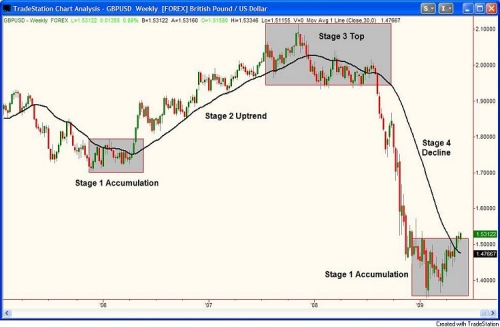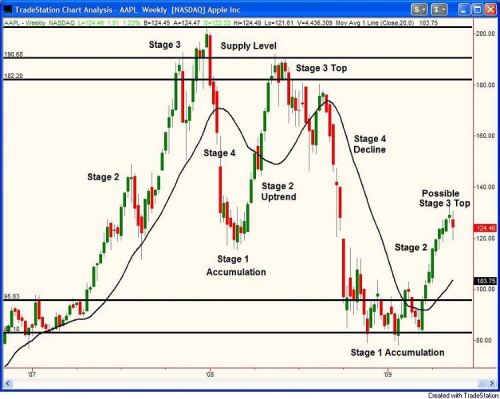For many of you, your trading and investing career is just beginning, and for others like me, it has been going on for a long time. My career began during the greatest bull market of all time, from 1990 - 2001. That market taught me a very important lesson that I want to share with you. It will help you understand trending markets, range bound markets, and above all, help you to control your emotions.
If you have been watching the stock market at all since late 2007, you have seen a period of high prices followed by a severe sell-off during 2008 and 2009. Hopefully, you did not buy or hold any stocks during this time, but if you did, you should have learned a valuable lesson. This lesson is no different than the first time you touched a hot stove as a child after being told not to do so by your mother. Like that experience of getting burned, this experience will only be helpful for you if you remember it the next time prices are high and everyone is telling you they are going much higher. This lesson is the focus of today's piece. It is applicable to any market and time frame you choose to trade.
The only way to keep yourself out of the trouble mentioned above and also profit from market periods like that is to know what trend the market is in and most importantly, know what the next trend is going to be. The chart below is a weekly chart of the GBPUSD (British Pound / US Dollar) showing a period of high prices near the end of 2007 and the sell-off that followed. Notice that I have marked off and numbered each of the basing periods and trending periods. The basing period after the last uptrend is called a Stage 3 top or distribution, and the current basing period after the sell-off is called a Stage 1 accumulation.
The 4 Stages:
Stage 1 accumulation
Stage 2 uptrend
Stage 3 top or distribution
Stage 4 decline

The Stage 1 accumulation phase is the period where the large players such as institutions, hedge funds, and market makers buy low from the public who is selling to limit losses from higher purchases, or selling to lock in any remaining gains from lower purchases. This selling pressure is the cause of the preceding Stage 4 decline phase. Once the last seller sells, price once again begins a new Stage 2 uptrend. This phase is also called the public participation phase because anyone who has money left from the decline phase sees the new uptrend and decides to buy to participate.
The Stage 2 uptrend has another name. It is called the greed stage because everything you do turns out right as long as you are long during this period of rising prices. It does not matter if you buy breakouts or pullbacks to enter into the market, because rising prices reward you as long as you are not short. This trading strategy is also known as buy high, sell higher. Eventually, price reaches a point where everyone who wants to buy has bought, and everyone needs to sell to take their gains. This begins another period of sideways trading as buyers and sellers move back into balance.
This basing period is called the Stage 3 top, or distribution phase. This is the time when the brokers begin calling the public encouraging them to buy in order to support the higher prices until the smart money has finished unloading (selling) their position. Think of the "super spike" oil upgrade by Goldman Sachs when oil was at $147.00 per barrel, or all the gold commercials on the television when gold reached $1000.00 per ounce recently. Unfortunately, once the last buyer buys, price will decline from this higher trading range and a new Stage 4 decline will begin. The Stage 4 decline is called the fear stage when the buyers who bought the top begin to hope that prices will come back. As prices fall further, panic selling usually follows, and everything learned about dollar cost averaging, and buy and hold goes horribly wrong. Depending on your age, this decline phase can be a disaster to your retirement, and other long-term plans. What the public does not know is that during the Stage 4 decline phase, they need to focus on shorting rallies rather than buying falling prices. If nothing else, they need to stay out of the market until prices move back into balance and the 4 stage cycle once again repeats. Each asset class has a similar cycle based on the economic cycle. Bonds recently topped out as the stock market bottomed, for example. I learned this lesson the hard way during the 2001 Stage 4 decline. Hopefully, this week's piece will help you avoid this pain in the future and also help you take advantage of it.
As we move forward, we will continue to analyze the currency markets using the 4 stages so as to stay on the right side of the trend. Make sure you chart all of your investments in this manner, and use trend lines to capture your gains going forward. Below is another chart to help you understand and identify with the key four stages of any market.

If you have been watching the stock market at all since late 2007, you have seen a period of high prices followed by a severe sell-off during 2008 and 2009. Hopefully, you did not buy or hold any stocks during this time, but if you did, you should have learned a valuable lesson. This lesson is no different than the first time you touched a hot stove as a child after being told not to do so by your mother. Like that experience of getting burned, this experience will only be helpful for you if you remember it the next time prices are high and everyone is telling you they are going much higher. This lesson is the focus of today's piece. It is applicable to any market and time frame you choose to trade.
The only way to keep yourself out of the trouble mentioned above and also profit from market periods like that is to know what trend the market is in and most importantly, know what the next trend is going to be. The chart below is a weekly chart of the GBPUSD (British Pound / US Dollar) showing a period of high prices near the end of 2007 and the sell-off that followed. Notice that I have marked off and numbered each of the basing periods and trending periods. The basing period after the last uptrend is called a Stage 3 top or distribution, and the current basing period after the sell-off is called a Stage 1 accumulation.
The 4 Stages:
Stage 1 accumulation
Stage 2 uptrend
Stage 3 top or distribution
Stage 4 decline

The Stage 1 accumulation phase is the period where the large players such as institutions, hedge funds, and market makers buy low from the public who is selling to limit losses from higher purchases, or selling to lock in any remaining gains from lower purchases. This selling pressure is the cause of the preceding Stage 4 decline phase. Once the last seller sells, price once again begins a new Stage 2 uptrend. This phase is also called the public participation phase because anyone who has money left from the decline phase sees the new uptrend and decides to buy to participate.
The Stage 2 uptrend has another name. It is called the greed stage because everything you do turns out right as long as you are long during this period of rising prices. It does not matter if you buy breakouts or pullbacks to enter into the market, because rising prices reward you as long as you are not short. This trading strategy is also known as buy high, sell higher. Eventually, price reaches a point where everyone who wants to buy has bought, and everyone needs to sell to take their gains. This begins another period of sideways trading as buyers and sellers move back into balance.
This basing period is called the Stage 3 top, or distribution phase. This is the time when the brokers begin calling the public encouraging them to buy in order to support the higher prices until the smart money has finished unloading (selling) their position. Think of the "super spike" oil upgrade by Goldman Sachs when oil was at $147.00 per barrel, or all the gold commercials on the television when gold reached $1000.00 per ounce recently. Unfortunately, once the last buyer buys, price will decline from this higher trading range and a new Stage 4 decline will begin. The Stage 4 decline is called the fear stage when the buyers who bought the top begin to hope that prices will come back. As prices fall further, panic selling usually follows, and everything learned about dollar cost averaging, and buy and hold goes horribly wrong. Depending on your age, this decline phase can be a disaster to your retirement, and other long-term plans. What the public does not know is that during the Stage 4 decline phase, they need to focus on shorting rallies rather than buying falling prices. If nothing else, they need to stay out of the market until prices move back into balance and the 4 stage cycle once again repeats. Each asset class has a similar cycle based on the economic cycle. Bonds recently topped out as the stock market bottomed, for example. I learned this lesson the hard way during the 2001 Stage 4 decline. Hopefully, this week's piece will help you avoid this pain in the future and also help you take advantage of it.
As we move forward, we will continue to analyze the currency markets using the 4 stages so as to stay on the right side of the trend. Make sure you chart all of your investments in this manner, and use trend lines to capture your gains going forward. Below is another chart to help you understand and identify with the key four stages of any market.

Last edited by a moderator:
